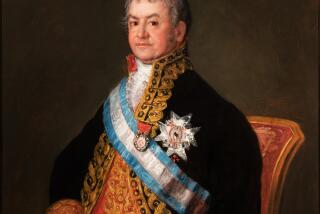A royal rendering of Voltaire
At the J. Paul Getty Museum last fall, a painting near the end of the great retrospective exhibition of French Enlightenment sculptor Jean-Antoine Houdon showed the artist at work in his studio. His friend Louis-Leopold Boilly painted Houdon in the midst of sculpting an academic figure from a nude model, seated to the right. A figural pyramid anchors Boillyâs composition, in good Neo-Classical fashion, with its stable base established by Houdon and his subject.
The apex of the visual pyramid is formed by a seated sculpture of Voltaire, philosopher and patriarch of the young French republic. The great liberal writer, who argued that culture and commerce rank on a par with politics and war in concepts of history, is made the centerpiece for scores of sculptures that fill the artistâs studio. A hugely popular work of art in its own right, the âSeated Voltaireâ here occupies the metaphoric pinnacle of Houdonâs prodigious output.
As well it might. Culture and commerce were Houdonâs twin engines as an artist, and this sculpture is especially powerful. Thatâs reason enough for the rare life-size plaster version that entered the collection of the Los Angeles County Museum of Art this week to be an exceptional addition. A gift of the Ahmanson Foundation, Houdonâs âSeated Voltaireâ goes on public view today.
The plasterâs history of ownership goes back just 75 years, to a collection in France. That created a potential problem, since a vogue for posthumous plaster casts of famous sculptures arose in the 19th century. Once questions of authenticity were answered to LACMAâs satisfaction, the acquisition was made. Curator Mary Levkoff, who has been on the sculptureâs trail for more than two years, believes this cast was originally painted in imitation of bronze.
Long since stripped of its color, itâs nowhere near as ethereally elegant as two other versions in smooth white marble, one in Paris and the other in St. Petersburg. (Look closely and you can see seams from the plaster mold -- across the chest and knees, the veined left hand, etc.) But the abraded plaster exudes a rumpled liveliness that makes the figure unusually approachable. Itâs a wonderful addition to a collection that has seen excellent 18th century paintings by Antoine Watteau and Hubert Robert acquired in recent years.
Houdon typically made several versions of successful works in different materials, and Voltaire was the subject of a variety of his portrait busts and standing figures. But the popularity of this particular version in the 1780s (and after) is easy to understand. Houdonâs seated sage is a stunning embodiment of humanity enthroned.
The writer is shown dressed in classical Roman garments, seated on a Neo-Classical chair. His large, bony hands grasp the chairâs arms, as he leans his torso slightly forward and turns his head to his right. Heâs regal but not remote, enduring but not static. Houdon creates a startling range of facial expressions, which subtly shift as you move around the sculpture.
Head-on, Voltaire looks introspective. His careworn eyes and sunken cheeks lend a wistful air.
From his left, where the forward lean is most emphatic, he appears nearly impatient, as if to say, âGet on with it Houdon, Iâve got things to do.â (Voltaire died shortly after posing for the work.) From his right, where the dense, cubic form of the body and chair appears solid and immovable, an almost beatific smile passes across his lips; it lends blissful gravity.
Once, a formal, full-length seated pose was mostly reserved for representations of kings and Christ. Here it was extended to an extraordinary human being. If the marvelous sculptureâs animated humanism seems familiar, perhaps thatâs because its subsequent lineage includes Daniel Chester Frenchâs monumental seated figure in the Lincoln Memorial, carved more than a century later.
More to Read
The biggest entertainment stories
Get our big stories about Hollywood, film, television, music, arts, culture and more right in your inbox as soon as they publish.
You may occasionally receive promotional content from the Los Angeles Times.











